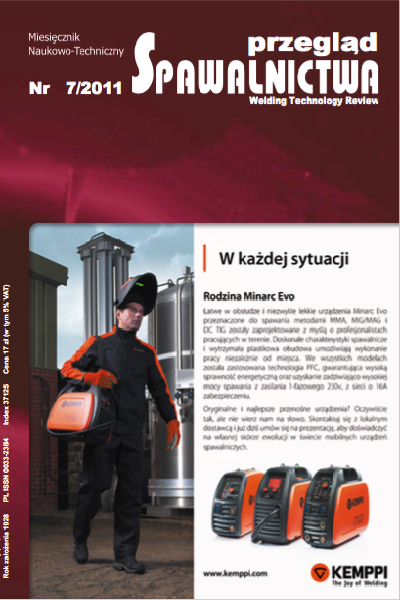Struktura złączy doczołowych odlewniczych stopów magnezu
Main Article Content
Abstract
W artykule przedstawiono ocenę struktury złączy odlewniczych stopów magnezu, wykonanych trzema metodami spajania: zgrzewaniem tarciowym z mieszaniem materiału zgrzeiny (FSW), spawaniem laserowym przy zastosowaniu lasera Co2 oraz spawaniem łukowym w osłonie gazu obojętnego elektrodą wolframową (TIG). oceniano makro- i mikrostrukturę złączy doczołowych przy zastosowaniu mikroskopu optycznego z układem cyfrowej rejestracji obrazu. Do badań zastosowano dwa stopy magnezu: AZ91 i AM-Lite, w których cynk i aluminium stanowią główne dodatki stopowe. Materiałem wyjściowym były gąski odlewnicze, które sfrezowano na określony wymiar, a następnie wycięto z nich płaskowniki o grubości 3 mm. Przeprowadzona ocena wykazała, że możliwe jest uzyskanie złączy ze stopów magnezu o wysokiej jakości. odnotowano jednak śladowe ilości porów w obszarze złącza.
Structure of butt joint of as-cast magnesium alloys
Abstract
The paper presents the structure of butt joints analysis of magnesium alloys welded with the use of friction stir welding (FSW), Co2 laser and tungsten arc method. The macro- and microstructure on the cross-sections perpendicular to the welding direction using optic microscope with image recording device have been analyzed. Two types of die-cast magnesium alloys: AZ91 and AM-Lite are used in the research. The main alloying ele- ments of the alloys are zinc and aluminum. The materials as ingot are delivered by manufacturer and then they are cut in plate samples of 3 mm thickness. The structure analysis show that achieved quality butt joints of magnesium alloys is possible to achieve, however the presence of some pores are also observed.
Downloads
Article Details
Creative Commons CC BY 4.0 https://creativecommons.org/licenses/by/4.0/
Welding Technology Review (WTR) articles are published open access under a CC BY licence (Creative Commons Attribution 4.0 International licence). The CC BY licence is the most open licence available and considered the industry 'gold standard' for open access; it is also preferred by many funders. This licence allows readers to copy and redistribute the material in any medium or format, and to alter, transform, or build upon the material, including for commercial use, providing the original author is credited.
References
Kulekci M.k., 2008, Magnesium and its alloys in applications in automotive industry, Journal of Advanced Manufacturing Technology, 39: 851-865.
Friedrich F. Schuman S., 2001, Research for a New age of magnesium in the automotive industry, Journal of Materials Processing Technology, 117: 276-281.
Cao X., Jahazi M., Immarigeon J.P., Wallace W., 2006, A review of laser welding techniques for magnesium alloys, Journal of Materials Processing Technology, 171: 188-204.
Abdel Aal A., 2008, Protective coating for magnesium alloy, Journal of Materials and Science, 43: 2947-2954.
Avedesian M.M., Baker H., 1999, Magnesium and magnesium alloys, ASM Specialty Handbook.
Vesling F., Ryspaev T., 2007, Effect of heat treatment on the superplasticity of magnesium alloys, Russian Journal of NonForrous Metals, 48: 57-62.
Lehner C., Reinhart G., Schaller L., 1999, Welding of diecasted magnesium alloys for production, Journal of Laser Applications; 11/5: 206-210.
Kołodziejczak P., kalita W., kolasa A., Spawanie stopów magnezu wiązką lasera CO2, Prace naukowe, Mechanika z. 215, s. 97-109.
